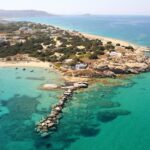Mani Travel Guide
Introduction
Mani Travel Guide: Embarking on a journey to Mani is an indescribable experience, as this region is known for its extraordinary and defiant nature that surpasses any poetic verses or satisfying prose. Exploring the rugged beauty of Mani through countless kilometers of driving reveals the true essence of this historically rich place. Numerous charming villages, grand architecture adorned with imposing towers, and awe-inspiring landscapes ranging from arid beaches to dry vistas paint a vivid picture of Mani’s captivating history. The monuments brimming with stories and the places of worship bear witness to the enduring spirit of the Mani people, forged over centuries and shaped by the passage of time. Begin your enigmatic exploration of Mani from the serene town of Gythio, venturing through its natural boundaries into the southern arid regions. From the ancient temple of Poseidon and Cape Tainaron to the iconic image of Vathia village, reminiscent of a genuine castle with abandoned yet evocative stone tower houses, and the picturesque Gerolimenas, once a bustling commercial port, each stop unveils a different facet of Mani’s allure. The prehistoric caves of Diros offer an encounter with “unspeakable beauty,” while the enchanting waters of Limeni and the traditional charm of Areopoli showcase the authentic essence of Greece. Indeed, Mani’s treasures can be explored endlessly throughout the year, but true understanding of its character lies in connecting with the Mani people themselves, the true soul of this extraordinary region, known for their unique temperament. Everywhere, the magnificent stone Mani towers stand tall, bearing witness to the Maniates’ bravery and telling stories of their rich family history. The timeless allure of the ghost villages and unspoiled beaches found in the Peloponnese countryside, coupled with the dramatic mountain vistas, make Mani a destination of unparalleled beauty. Its rugged coastline and imposing cliffs create a striking contrast against the sea, offering a desolate and barren backdrop along hiking trails punctuated by majestic stone towers. A journey to Mani may not be glamorous, but it undeniably offers an experience unlike any other.

Where is Mani?
Mani is situated in the southern region of Greece, specifically in the central peninsula that extends southwards from the Peloponnese. It is bounded by the Laconian Gulf to the east and the Messenian Gulf to the west. The Mani peninsula is an extension of the Taygetos mountain range, which acts as the prominent backbone of the Peloponnese. To find more detailed information about Mani and the surrounding area, you can refer to the Messenia Travel Guide
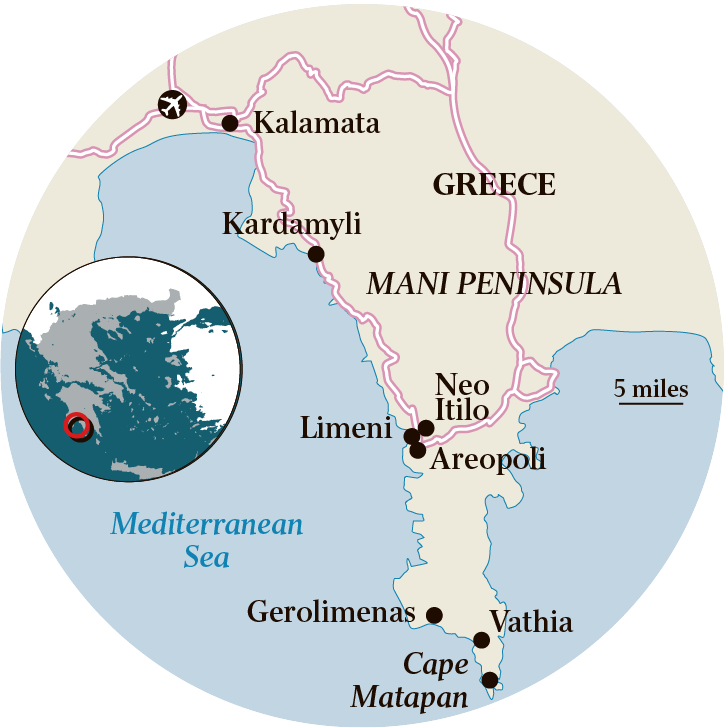
By air: The nearest airport to Mani is located in the town of Kalamata. Several international flights are currently operating to and from this airport.
By car: If you are planning to visit Messiniaki Mani (Stoupa Kardamili), the recommended route from Athens is to take the road leading to Kalamata. After reaching Kalamata, the road becomes somewhat winding. It usually takes approximately 3 to 3.5 hours to reach Stoupa.
For those heading to Lakoniki Mani (Oytilo, Areopoli), it is advisable to take the road from Athens to Sparta. The journey to Areopoli typically takes about 3.5 hours. Fortunately, both roads to Kalamata and Sparta are relatively new, although toll fees should be expected (around €20 each way). To fully experience the wonders of Mani, renting a car is highly recommended, allowing you to explore all the remarkable sights. Alternatively, you have the option of taking a cruise around Mani, which provides an excellent opportunity to visit certain villages by sea. However, opting for a cruise may result in missing out on the complete Mani experience. Mani is a truly distinctive destination in Greece, characterized by breathtaking landscapes, rugged mountains, olive groves, and villages reminiscent of towers
Gythio, the capital of Mani
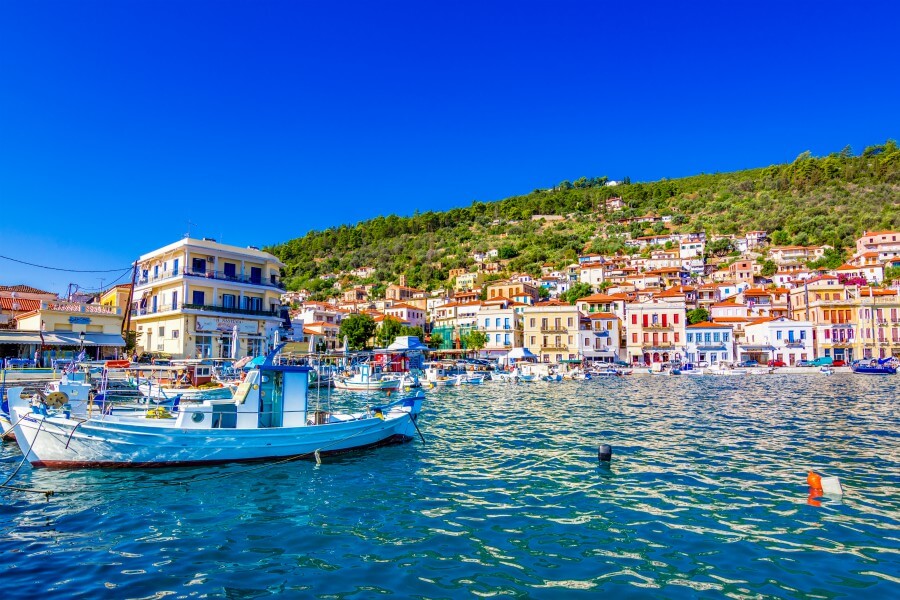
Recognized as the capital of Mani, the charming town of Giteio serves as a serene coastal retreat and an ideal base for exploring the Mani Peninsula. Taking a stroll along the waterfront promenade in Giteio unveils some of the most stunning vistas the city has to offer. The harbor, adorned with its traditional fishing boats, epitomizes the captivating essence of Giteio. Nestled like an amphitheater on the slopes of Mount Akoumaro, Giteio whispers tales of its seafaring heritage. Indulging in a seaside dining experience is highly recommended for those visiting Giteio during the summer months. Travelers seeking to truly uncover the hidden gems of Giteio should consider venturing through the city itself, allowing themselves to meander along its streets and discover the enchanting neighborhoods adorned with delightful courtyards from the past.
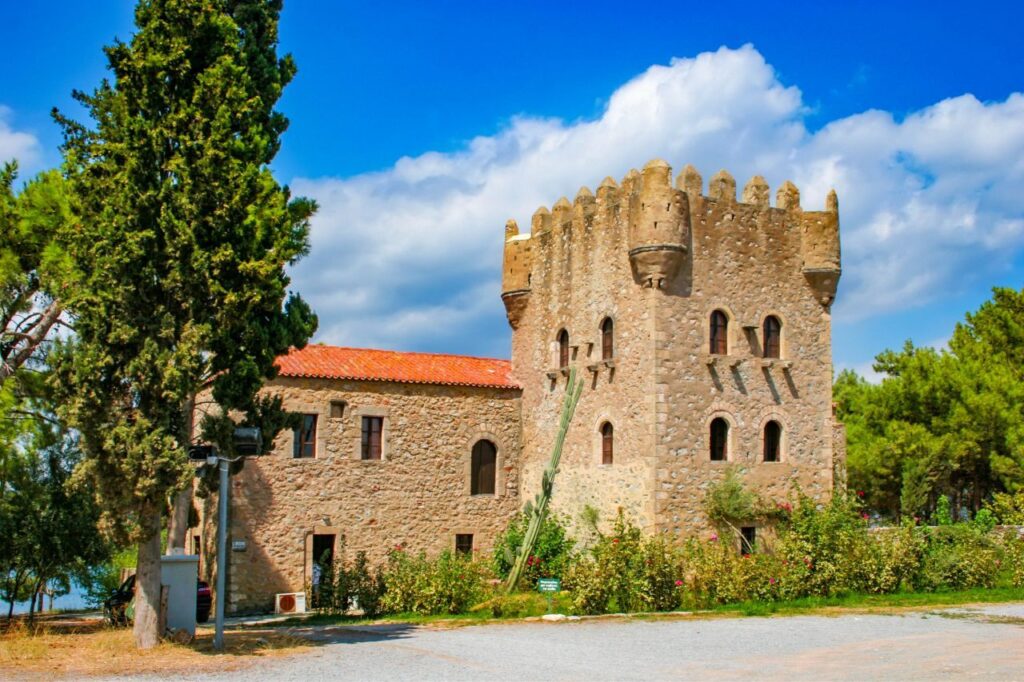
One of the most captivating landmarks in Ghithio is the Town Hall, located across the harbor. This architectural marvel has graced the town for approximately 120 years and stands out prominently with its impressive design. Among the top attractions to visit is Cranae Island, which was once four times its current size. Over time, the island’s shape and dimensions have been altered by weather and geological changes, transforming it into a peninsula. Despite being accessible by foot or car, it is still referred to as an island. According to legend, it is believed that Paris and Helen spent a night on this island after escaping from Menelaus’ palace in Sparta. The island derives its name from the Greek word for helmet, “kranos,” as a tale suggests that a Trojan prince lost his helmet here. However, an alternative theory proposes that its name originated from the ancient Greek term “Kranaos,” meaning barren and dry. Travelers are encouraged to explore the picturesque pine forests that adorn Cranae Island, as well as visit notable sites such as the Chapel of Agios Petros, the Kuranai Lighthouse, and the Tower of Tzanetakis. The tower, constructed in 1829 by a prominent member of one of the largest Mani families, Tzanetakis-Grigorakis, houses the Museum of History and Ethnology of Mani. Inside the tower, visitors can immerse themselves in the “Mani Traveler: 15th to 19th century” exhibition, which provides a wealth of information about the experiences and writings of foreign travelers who have explored and documented their encounters with Mani. It offers a fascinating insight into the region’s history.
Discover Cape Tainaron, the Gate of Hades
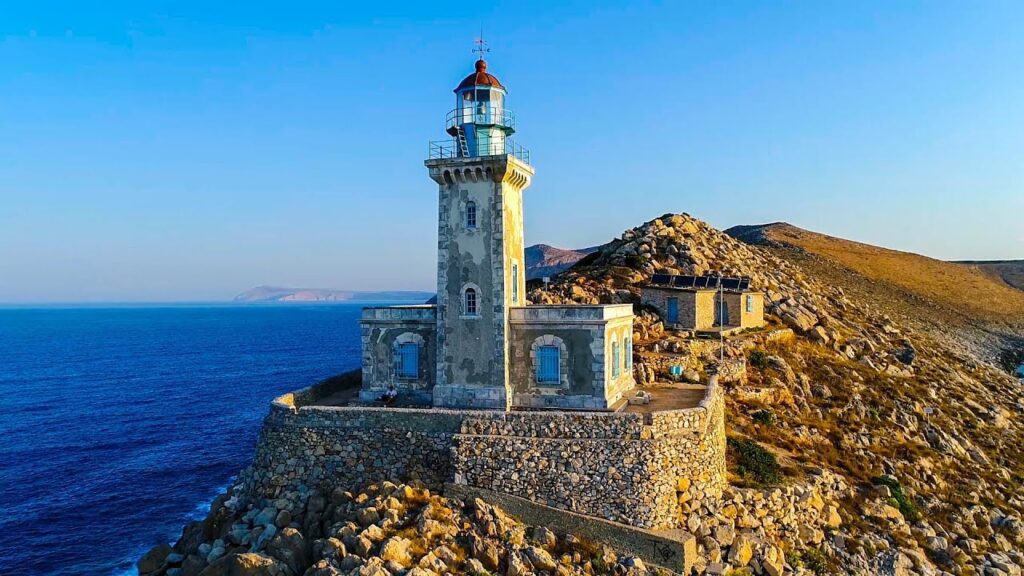
The charm of Cape Tainaron remains undiscovered by those who are unfamiliar with its distinctive appeal. Positioned at the southernmost point of East Mani, in close proximity to Giteio, Cape Tainaron guarantees an extraordinary and unforgettable adventure. Journeying south from Kotronas towards the village of Kokkaras, travelers will encounter an archetypal Mani village characterized by traditional stone houses and historic towers dating back to the 18th century. Referred to as Vascia, this village exemplifies Mani’s architectural legacy and is celebrated as one of the region’s most picturesque settlements. Although now abandoned, the clustered residential structures perched high above the azure sea create a mesmerizing spectacle, showcasing the allure of the Peloponnese. While a recent attempt to transform Vathia into a luxurious hotel proved unsuccessful, the nearby Lagia Village still stands as an impressive example of unique Mani architecture. Along the way to the Tainaron ruins, explorers will stumble upon Porto Cayo, a delightful harbor located on the remnants of the ancient city of Psamathus.
Continuing the journey towards Cape Tainaron evokes an overwhelming sense of wonder. Few places in Greece possess such a rich tapestry of myths and legends. Tainaron, also known as Cape Matapas, represents the southernmost point of continental Europe and was believed to be one of the Gates of Hades in ancient times. According to legend, it was here that Orpheus ventured into the underworld in search of his beloved Eurydice, Hercules confronted Cerberus, and Odysseus followed Tainaron to encounter the soul of Achilles. Surrounded by the vast Aegean Sea, the rugged landscape of Cape Tainaron still preserves the wild essence that has captivated countless hearts throughout history. The site is also home to a significant sanctuary of Poseidon, boasting an impressive mosaic floor dating back to the 1st century AD, providing evidence of Roman settlements in later periods.
In addition to its awe-inspiring vistas, Cape Tainaron offers solace to nature enthusiasts through the magnificent Tainaron Lighthouse. Standing at a height of 16 meters, this lighthouse, erected in 1882, continues to guide ships navigating through one of the busiest maritime routes in the Mediterranean. Embarking on a spectacular hike towards Cape Tainaro, visitors inevitably succumb to the enchantment of the scenic route. Arguably, Cape Tainaro offers the most gratifying views in the entire Mani Peninsula, commanding a panoramic vista of the Gulf of Laconia and leaving an indelible impression on all who behold its grandeur.
Gerolimenas, the Land of Towers
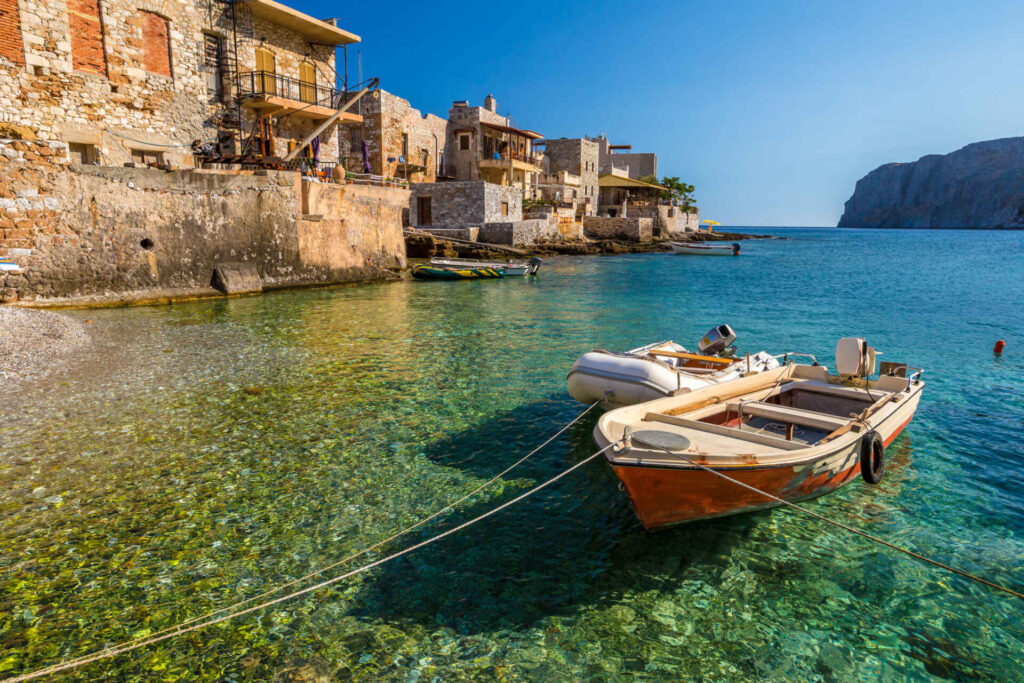
In the pure paradise of Mani, the journey continues across the rugged terrain of the Peloponnese peninsula. Truly, Mani can be explored for days and weeks, regardless of the season. However, to truly grasp the essence of Mani’s character, one must engage with the Mani people themselves, as they embody the soul of this region with their unique temperament. We will share with you their rich family history, which is prominently represented by the remarkable stone Mani towers, narrating tales of the Maniates’ bravery.
Continuing the route from Giteio to Tainaro, travelers will venture into the eastern part of Mani, offering an opportunity to explore the western region. Our initial stop is the breathtaking Gerolimenas. This picturesque coastal village provides a serene haven, overlooking the majestic Cabo Grosso. Although Gerolimenas may not be the bustling commercial port it once was, its name is derived from the Greek words “Ieros” (sacred) and “Limin” (port), signifying its significance as the sacred port of Mani. It is now considered one of the prime destinations, boasting stunning views and recent infrastructural developments. Just 5 kilometers away from Gerolimenas lies the iconic village of Kita, renowned for its grand Mani tower, a symbol of pride for its inhabitants. Another intriguing suggestion is to visit the settlement of Stavri, which holds an air of mystery. Adventurous hikers can embark on an unforgettable trek to the Mina Castle, constructed by the Franks in 1248, nestled at the end of a lengthy promontory amidst the rocks.
Tigani Cape, A Historical Place
The ruins of Maini Castle, believed to be the oldest castle in Mani and constructed during the reign of Emperor Justinian, are scattered across Cape Tigani. Situated on a rocky outcrop within the protected bay of Mesapos, this peninsula resembles a frying pan, hence the name ‘Tigani’. Exploring this breathtaking walking route, avid travelers will encounter remnants of walls enclosing houses, churches, reservoirs, and cliffs. The sheer grandeur of this site has earned it the title of Grand Magne on numerous occasions, as recognized by historians and visitors alike. According to the Morea Chronicle, the castle, possibly of Frankish origin, was erected by William II Villehardouin, the Prince of Achaia, to exert control over the Slavic population residing on Mount Taygetus. It was later captured by the Byzantines during the Battle of Pelagonia in 1259. While there may be some debate about whether Cape Tigani is the exact location of the castle, Porto Cayo is also considered a possible site. Nonetheless, embarking on this hiking route starting from Stavri is certain to provide travelers with a remarkable and awe-inspiring experience. It is a place of dramatic beauty and undeniable impressiveness.
Diros, A Setting of Unspeakable Beauty
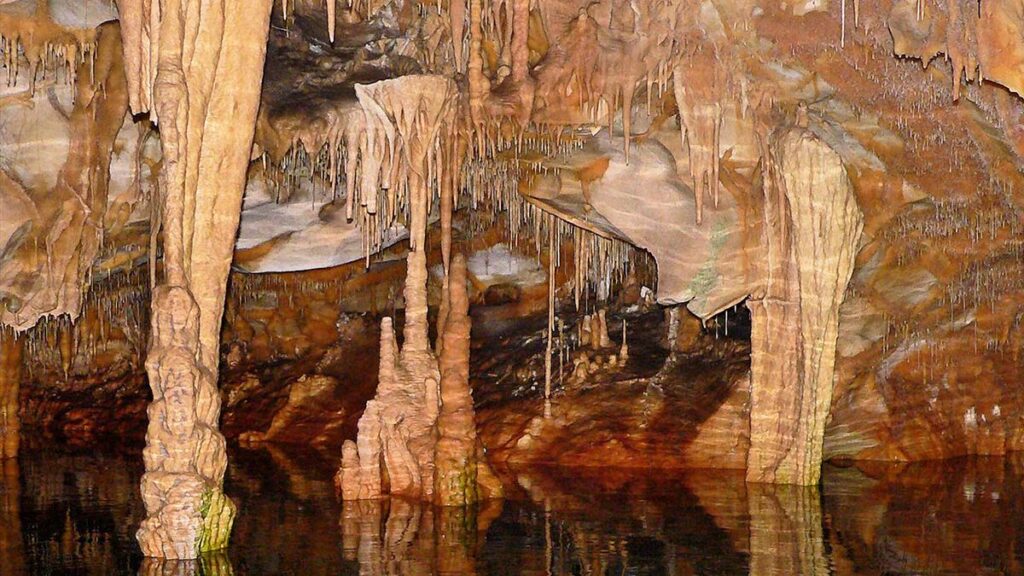
Among the myriad of attractions in Mani, one stands out as the ultimate highlight—the Dilos Caves, which rank among the most awe-inspiring sea caves worldwide. While the description may seem overwhelming, the reality is even more breathtaking. If you choose to embark on a boat excursion to explore this astonishing marvel of indescribable beauty, you will have the opportunity to venture inside the Dilos Caves. However, that’s not all—this journey is not one you can simply walk through. Instead, it entails an exhilarating 45-minute boat ride along a winding underground river, stretching approximately 2.5 kilometers. It is an experience that truly transports you to a realm that feels like a black hole within an undiscovered universe. As you lean against the crystalline formations that adorn the entire cave (beware if you suffer from claustrophobia!), you will find yourself immersed in an environment with a constant temperature of 18°C. Diros Cave is renowned as one of the most significant Neolithic caves globally, covering a total area of approximately 34 square meters. However, it was only in 1958 that speleologist John Petrochiros first explored a mere 5,000 meters of its vast expanse. Subsequently, in 1970, archaeological research led by archaeologist Georgios Papathanassopoulos commenced, delving into the Arepotlipa and Vlychada caves, also first explored by Petrochiros and his wife Anna. The passages within the Vlychada cave span an area of 16,700 square meters, yet only 2,800 channels have been explored to date. Undoubtedly, visiting the Dilos Caves provides an unparalleled sensation and an experience that will touch your soul forever.
Areopolis, the city of Ares
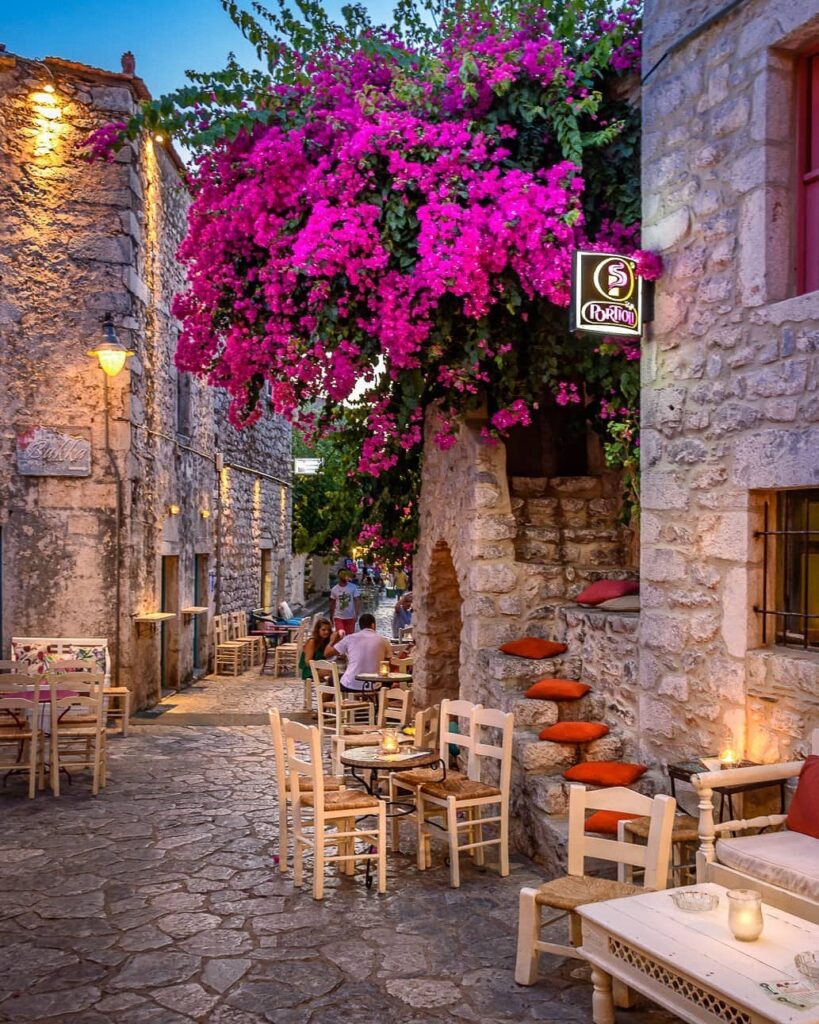
When visiting Mani, one of the most remarkable attractions that captivates all who behold it is the Dilos Caves, renowned as one of the most breathtaking sea caves worldwide. Although the description may sound overwhelming, the reality exceeds all expectations. If you consider embarking on a boat journey to explore this astonishing spectacle of unparalleled beauty, you can actually venture inside the Dilos Caves. But that’s not all—walking is not an option here. Instead, prepare for a truly awe-inspiring 45-minute boat ride along a winding passageway, stretching 2.5 kilometers within an underwater river. This unforgettable experience will make you feel as if you have discovered a black hole within an unknown universe. Picture yourself leaning against the crystalline formations that adorn the entire cave, immersing yourself in an environment that defies description (though those with claustrophobia should take caution!). With a constant temperature of 18°C, Diros Cave holds immense significance as one of the most important Neolithic caves globally. The cave spans a total area of approximately 34 square meters, yet it was only in 1958 that speleologist John Petrokiros first explored a mere 5,000 meters of its vast expanse. The Arepotlipa and Vlychada caves, initially explored in 1958 by speleologists Ioannis and Anna Petrokiros, became subjects of archaeological research led by archaeologist Georgios Papathanassopoulos in 1970. The passages within the Vlychada cave cover an area of approximately 16,700 square meters, with only 2,800 channels having been explored to date. Undoubtedly, visiting the Dilos Caves offers a truly unique and soul-stirring experience that will leave an indelible mark upon your memory.
Oitylo, an Authentic Sensation
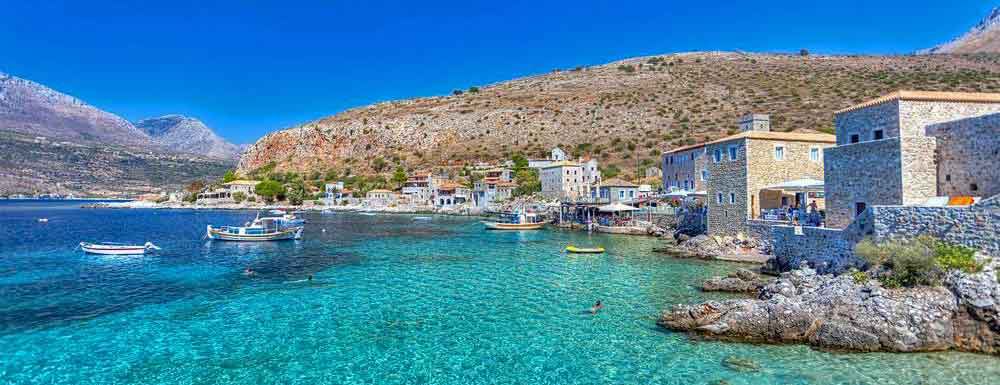
Situated to the north of Areopolis, adventurous travelers are presented with an irresistible opportunity to explore the enchanting Oytilo Gulf, a region that seamlessly blends charm with historical significance. Along the picturesque coastline, three settlements eagerly await discovery. The first captivating stop on this journey is the delightful village of Limeni, renowned for its charming fish taverns and tranquil atmosphere that beckons visitors with open arms. Before arriving at Limeni, take a leisurely stroll through the quaint neighboring villages, where stone towers majestically overlook the bay’s sparkling turquoise waters, creating a truly picturesque spectacle. Merely 2 kilometers away lies the idyllic village of Neo Oytilo, a perfect spot to unwind and soak in the seaside bliss. Continuing a little further along, the charming village of Karavostasi reveals itself, a place that once served as a bustling trading port in ancient times. Oytilo, boasting a rich history spanning millennia, holds a distinction uncommon in the Mani region, with historical records tracing its continuous settlement back to the era of Homer. While much of Mani is characterized by barren and rugged landscapes, ancient Oytilo surprises visitors with its abundance of olive trees, adding a touch of variety and vibrancy to the region. No visit to Oytilo would be complete without venturing to the Monastery of Decro, a hidden gem that shelters exquisite paintings rarely found in Orthodox monasteries. These remarkable and captivating artistic masterpieces depict Jesus at the center of the zodiac, adding an additional layer of allure and fascination to the monastery’s ambiance.
Kiss Night Goodbye from Mani
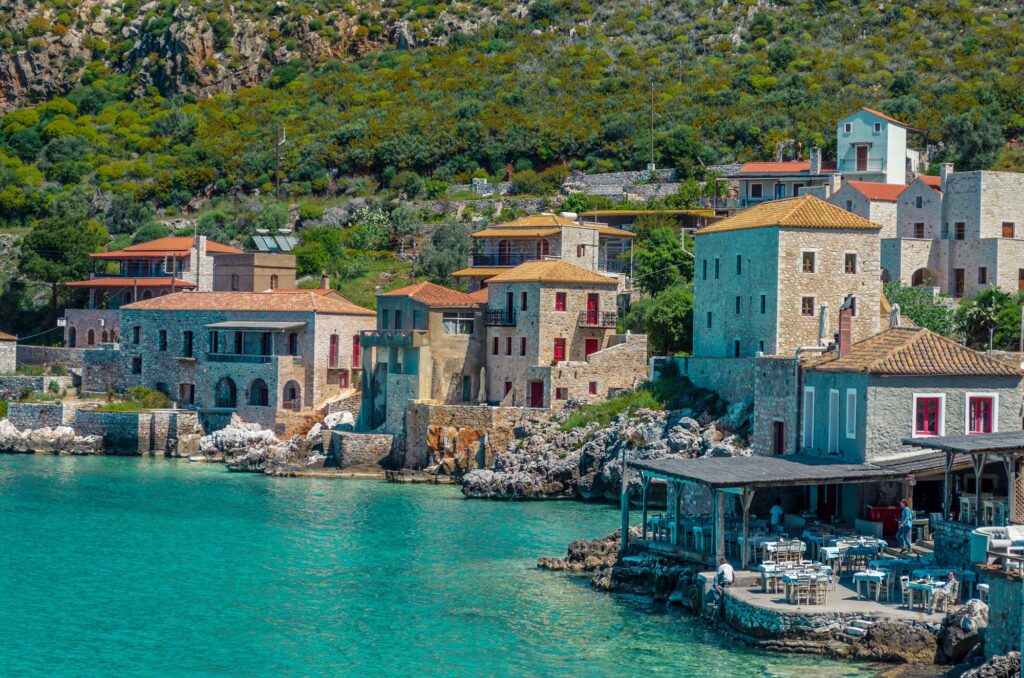
Mani is renowned as an extraordinary and defiant region that transcends even the most enchanting verses and captivating poems, so be prepared for an unforgettable journey to Mani. Exploring the rugged beauty of Mani unveils the true essence of this historic destination. With its numerous picturesque villages, remarkable architecture featuring imposing towers, breathtaking landscapes encompassing arid beaches and striking terrains, as well as monuments steeped in history, Mani reveals the captivating spirit of its people who possess a notorious and spirited temperament that has evolved over the centuries. Truly, Mani offers endless exploration that can span days and weeks throughout the year. However, to truly grasp the essence of Mani’s character, it is essential to engage with the Mani people themselves, as they are the heart and soul of this unique region. They will guide you through the mysteries of this “sacred” place and share their family histories, symbolized by the majestic stone Mani towers that narrate tales of the Maniates’ bravery. Nestled within the timeless beauty of the Peloponnese, Mani showcases ghost villages and pristine beaches that adorn the countryside, while boasting some of Greece’s most awe-inspiring mountain landscapes. A trip to Mani is an enchanting and captivating experience that will leave an indelible mark on your memory.
Special Addendum : The Shipwreck of Dimitrios

Near Giteio, visitors have the opportunity to explore the wreck of the Dimitrios ship. The Dimitrios was a 65-meter freighter that ran aground at Baltaki Beach in 1981 and was subsequently abandoned. There are various stories surrounding its fate, ranging from ghostly legends to smuggling tales, but the truth is likely more mundane. It is believed that the ship’s abandonment was a result of financial difficulties and the dismissal of the crew, leaving it stranded in Valtaki. Valtaki itself is a beautiful beach, adorned with unique artifacts, making it a destination not to be missed.
When it comes to dining in Mani, the Peloponnese region, here are some recommendations:
Kardamilli: A tavern I have frequented several times is Kyria Lela in Kardamili. It is nestled in a courtyard shaded by vine leaves and offers breathtaking sea views. The traditional Greek food, known as “mageirefta,” is excellent, and don’t forget to try the Politiki salad.
Kariovouni or Arachova: This mountain village near Stoupa is worth a visit. In the village square, shaded by plane trees, you’ll find the most amazing souvlaki (pork skewers). If you visit in the evening, be prepared for cooler temperatures and bring a jacket.
Limeni: To Magazaki Tis Todras is one of my favorite spots, located in the Limeni Bay with tables overlooking the sea and the Tower House. The owner, Thodora, is friendly and hospitable. You can savor various dishes based on local Mani cuisine, and it’s also a great place to enjoy coffee or ouzo while swimming in Limeni.
Areopoli: Barbara Petros is a charming establishment located in the alleys of Areopoli. They have a pleasant courtyard for lunch and outdoor tables in the evenings, providing a delightful atmosphere for dining.









